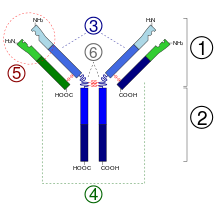Paratope

1. Antigen-binding fragment (Fab)
2. Antibody crystallizable region (Fc)
3. Heavy chains
4. Light chains
5. Variable region of the antibody. The paratope is the key-shaped section that makes direct contact with the antigen.[1]
6. Hinge regions
In immunology, a paratope, also known as an antigen-binding site, is the part of an antibody which recognizes and binds to an antigen.[1][2] It is a small region at the tip of the antibody's antigen-binding fragment and contains parts of the antibody's heavy and light chains.[1][2] Each paratope is made up of six complementarity-determining regions - three from each of the light and heavy chains - that extend from a fold of anti-parallel beta sheets.[2] Each arm of the Y-shaped antibody has an identical paratope at the end.[2]
Paratopes make up the parts of the B-cell receptor that bind to and make contact with the epitope of an antigen.[2] All the B-cell receptors on any one individual B cell have identical paratopes.[2] The uniqueness of a paratope allows it to bind to only one epitope with high affinity and as a result, each B cell can only respond to one epitope. The paratopes on B-cell receptors binding to their specific epitope is a critical step in the adaptive immune response.
Design of paratopes between species
The design and structure of paratopes can differ greatly between different species. In jawed-vertebrates, V(D)J recombination can result in billions of different paratopes.[3][4] The number of paratopes, however, is limited by the composition of the V, D, and J genes and the structure of the antibody.[3] Thus, many different species have developed ways to bypass this restriction and increase the diversity of possible paratopes.
In cows, an extra-long complementarity-determining region is considered to have an essential role in diversifying paratopes.[3][5] Additionally, both chickens and rabbits use gene conversion to increase the number of paratopes that are possible.[3]
References
- ^ ISBN 978-1-4419-9863-7.
- ^ OCLC 1002672752.)
{{cite book}}: CS1 maint: location missing publisher (link - ^ PMID 26188469.
- PMID 20651744.
- PMID 23746848.
